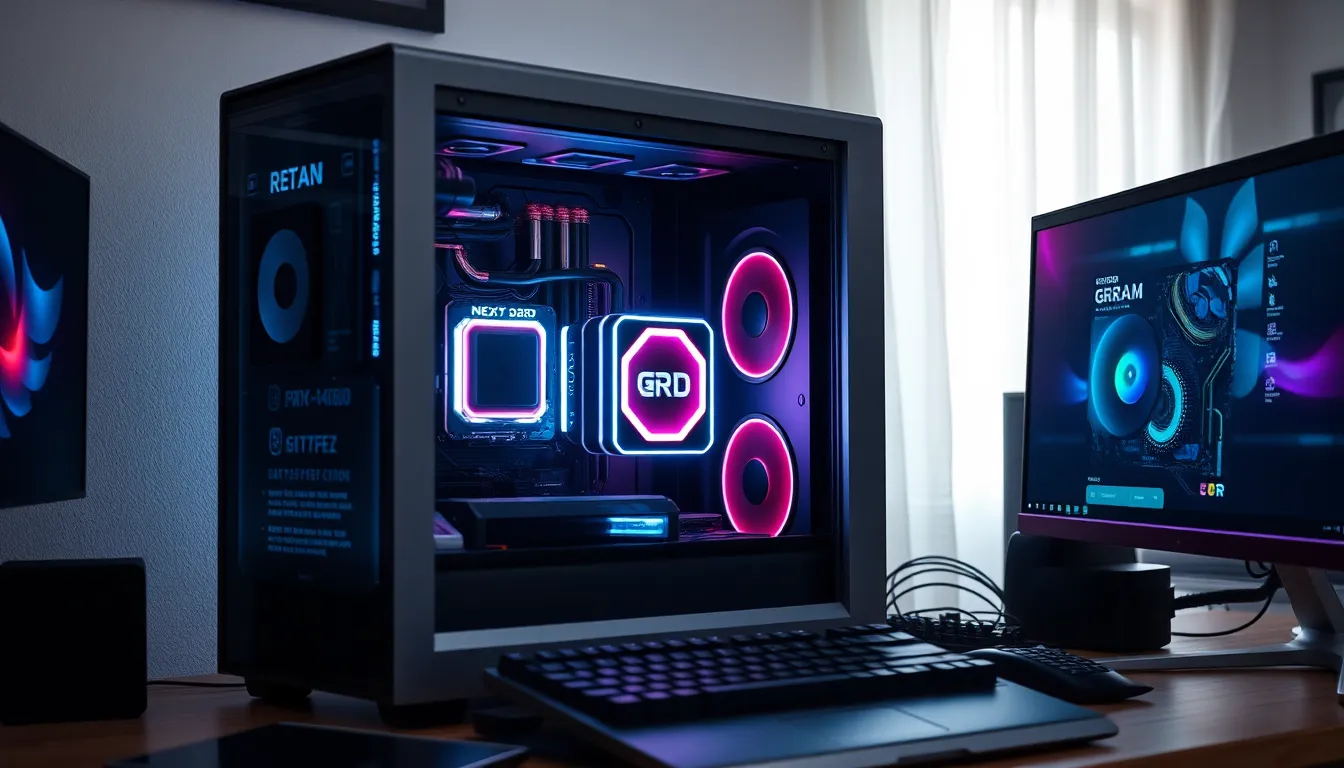In a world where speed is king and efficiency reigns supreme, next-gen processors are the unsung heroes of modern technology. These marvels of engineering promise to take computing power to dizzying heights, making your old laptop feel like a sloth on a lazy Sunday. If you thought your device was fast, wait until you meet the processors that could probably solve a Rubik’s Cube while brewing your morning coffee.
Imagine a world where lag is a thing of the past and multitasking feels like a walk in the park. Next-gen processors are not just about raw power; they’re about transforming the way we interact with technology. Whether it’s gaming, content creation, or simply streaming cat videos, these processors are set to redefine performance. Buckle up as we dive into the exciting realm of next-gen processors, where innovation meets speed and a sprinkle of humor makes everything better.
Table of Contents
ToggleOverview of Next-Gen Processors
Next-generation processors represent a significant leap in technology, focusing on improved performance and efficiency. These processors leverage advanced architectures to boost computing power, enabling users to experience remarkable fluidity in applications. Performance in demanding tasks such as gaming, content creation, and data analysis sees notable upgrades.
Technologies like artificial intelligence and machine learning are integrated into these processors, enhancing their ability to optimize workloads dynamically. Architectures built on smaller node processes contribute to reduced power consumption and heat output, translating to energy savings for users. This makes next-gen processors a sustainable choice for high-performance computing.
Multicore designs offer additional advantages. These processors typically feature more cores than their predecessors, facilitating better multitasking and multitasking capabilities. Users can run complex software without experiencing slowdowns, fostering seamless transitions between tasks.
Furthermore, compatibility with advanced graphics technologies enhances visual experiences. Support for real-time ray tracing and better image processing allows for lifelike graphics in gaming and professional applications. Innovations in memory management also contribute to faster data access, improving overall system responsiveness.
Manufacturers continue to push the boundaries of what’s possible. Upgrades in clock speeds and cache sizes will ensure that next-gen processors remain viable solutions for developers and end-users alike. This ongoing evolution guarantees that users benefit from increasingly powerful and efficient computing options.
Key Features and Innovations

Next-generation processors showcase impressive enhancements in performance and efficiency. These technological advancements offer transformative experiences across various applications.
Enhanced Performance
Enhanced processing power defines next-gen processors, enabling seamless multitasking and superior gaming experiences. Performance improvements stem from sophisticated multicore architectures that allow simultaneous execution of demanding applications. High clock speeds contribute to rapid data handling, enhancing overall fluidity during usage. Real-time optimization from integrated artificial intelligence significantly boosts workload management. This optimization leads to a dramatic reduction in latency, facilitating immediate response times in software applications. Upgraded cache sizes also improve data retrieval speeds, resulting in a more efficient workflow for users. Manufacturers consistently innovate these processors, ensuring they meet the evolving needs of both developers and consumers.
Energy Efficiency
Energy efficiency ranks as a pivotal feature of next-gen processors, promoting sustainability without sacrificing power. Smaller fabrication nodes play a crucial role in reducing energy consumption while enhancing performance capabilities. This reduction in power use translates into less heat production, facilitating cooler, quieter operations during intensive tasks. Manufacturers incorporate advanced power management technologies that dynamically adjust performance based on workload demands. As a result, these processors maintain optimal efficiency, which is vital for mobile devices and data centers alike. Overall, the drive for energy-efficient architectures ensures long-term viability and establishes a green computing standard in the technology industry.
Comparisons with Previous Generations
Next-generation processors exhibit significant advancements compared to their predecessors, particularly in architecture and speed. These innovations enhance overall computing experiences.
Architecture Improvements
Architecture improvements play a crucial role in next-gen processors. Enhanced multicore designs allow for more efficient task distribution, increasing parallel processing capabilities. Smaller node processes, typically at 5nm or below, contribute to increased transistor density, improving performance without increasing power consumption. Moreover, the integration of artificial intelligence within the core architecture enables adaptive performance, adjusting operations based on real-time demands. These changes make next-gen processors more versatile and efficient than previous generations, driving faster and smoother experiences.
Speed and Reliability
Speed and reliability take center stage with next-gen processors. High clock speeds, often exceeding 5 GHz, offer significant performance boosts for applications that demand quick processing. Moreover, improved cache sizes enhance data access speeds, minimizing latency during intensive operations. Reliability also benefits from advanced error correction technologies, reducing system crashes and ensuring stable performance across varied workloads. When compared to previous generations, these processors not only deliver quicker results but also maintain consistent performance during heavy multitasking scenarios, reflecting a major advancement in computing technology.
Impact on Various Industries
Next-generation processors are revolutionizing diverse industries, enhancing performance and efficiency. Their advanced architectures significantly influence gaming and artificial intelligence sectors.
Gaming and Entertainment
Gaming experiences benefit tremendously from next-generation processors. Improved multicore capabilities enable developers to create rich, immersive environments without lag. High clock speeds over 5 GHz deliver seamless frame rates, crucial for competitive gaming. Additionally, larger cache sizes enhance data retrieval speed, creating smoother gameplay. Gamers enjoy quicker load times and improved graphics, elevating overall enjoyment. With the integration of artificial intelligence, developers can create dynamic in-game behaviors, making experiences more engaging. Enhanced processing power also allows for virtual reality advancements, where realism is paramount. Players can expect more vibrant graphics and lifelike simulations, setting a new standard for entertainment.
Artificial Intelligence and Machine Learning
Next-generation processors drive advancements in artificial intelligence and machine learning. Their ability to handle complex algorithms allows for faster data processing and analysis. Enhanced performance enables real-time decision-making, crucial for applications like autonomous vehicles and smart assistants. Multi-core architectures optimize workload distribution, ensuring efficient handling of simultaneous tasks, a must for AI workloads. These processors even learn and adapt, improving their effectiveness over time. Energy efficiency plays a vital role as well, with smaller fabrication nodes promoting sustainable AI development. Organizations can utilize these advanced processors to enhance model training and execution times, ultimately leading to more robust AI solutions.
Trends Shaping the Future of Processors
Advancements in next-generation processors continue to redefine technological boundaries. Emphasis on artificial intelligence integration shapes their architecture, making these processors capable of optimizing workloads dynamically. Developers leverage this AI capability to facilitate real-time performance adjustments based on specific tasks.
Smaller fabrication nodes, typically at 5nm or smaller, play a critical role in enhancing energy efficiency. These nodes lead to increased transistor density, which offers improved performance without raising power consumption. Innovations in this area support sustainability objectives by reducing heat output and energy use in high-performance computing environments.
The emergence of advanced multicore architectures enhances multitasking capabilities. These architectures enable efficient task distribution across cores, resulting in improved processing speeds for demanding applications. Scalability becomes more feasible, allowing systems to handle complex algorithms with ease.
In gaming, transformative impacts arise from the increased computing power of next-gen processors. These processors allow for immersive gaming experiences characterized by seamless frame rates and reduced load times. Developers utilize this performance boost to create richer visual environments, raising user engagement levels.
Game developers focus on utilizing these processors to enhance in-game behaviors, introducing new levels of interaction. The evolution in virtual reality technologies benefits from the speed and responsiveness that next-gen processors provide, setting new standards for immersive experiences.
Moreover, the capabilities of next-gen processors extend to artificial intelligence applications. Their ability to process vast amounts of data rapidly is crucial for advanced technologies like autonomous vehicles and smart assistants. Enhanced power management features allow these processors to maintain efficiency while coping with complex workloads.
Manufacturers consistently innovate to stay ahead of industry demands. Trends in next-generation processors reflect a potential shift towards balance between power, speed, and energy consumption. Developers and businesses alike find that these innovations lead to more robust solutions tailored for diverse applications.
Next-generation processors are set to revolutionize the landscape of computing. With their advanced architectures and AI integration, these processors promise to deliver unmatched performance and efficiency. Users can expect smoother multitasking and enhanced experiences in gaming and content creation.
As technology continues to evolve, the focus on energy efficiency and sustainability will remain paramount. The innovations in smaller fabrication nodes and sophisticated multicore designs will ensure that next-gen processors not only meet but exceed the demands of modern applications.
This wave of technological advancement is not just about speed; it’s about redefining what’s possible in computing. The future looks bright as these processors pave the way for more powerful and efficient solutions across various industries.



